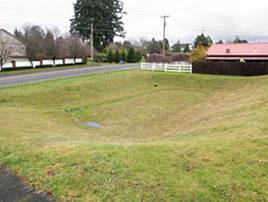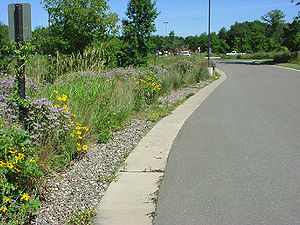
Difference between revisions of "BMPs for stormwater infiltration"
m |
m |
||
| Line 68: | Line 68: | ||
==Infiltration trench== | ==Infiltration trench== | ||
| − | [[file:Infiltration trench Lino Lakes.jpg|thumb|300px|alt=Photo of a Infiltration trench in Lino Lakes|<font size=3>Photo of a Infiltration trench in Lino Lakes</font size>]] | + | [[file:Infiltration trench Lino Lakes.jpg|left|thumb|300px|alt=Photo of a Infiltration trench in Lino Lakes|<font size=3>Photo of a Infiltration trench in Lino Lakes</font size>]] |
{| class="wikitable" style="float:right; margin-left: 10px; width:500px;" | {| class="wikitable" style="float:right; margin-left: 10px; width:500px;" | ||
Revision as of 13:49, 26 May 2015
Best Management Practices that infiltrate stormwater runoff into underlying soil include, but are not limited, to
- infiltration basins,
- infiltration trenches,
- underground infiltration,
- bioinfiltration,
- permeable pavements, and
- tree trenches and tree boxes.
These are discussed briefly below.
Infiltration basin
| Applications | Treatment capabilities3, 4, 5 | ||
| Residential | yes | TSS | High6 |
| Commercial | Yes | TN | Medium/high |
| Unltra-urban | Limited1 | TP | Medium/high |
| Industrial | Yes2 | Chloride | Low |
| Highway/road | Limited | Metals | High |
| Recreational | Yes | Oils and grease | High |
| Pathogens | High | ||
| 1 Due to a size restriction; 2 Unless the infiltration practice is located in an industrial area with exposed significant materials or from vehicle fuelling and maintenance areas. Infiltration BMPs are PROHIBITED in these areas; 3Underground infiltration systems will have different pollutant removal capabilities than what is provided in this table. These systems may have a wider application range, however, there is concern that they do not provide adequate treatment of the pollutants; 4 This is only for the portion of flow that enters the infiltration basin; by-passed runoff does not receive treatment; 5 Low = < 30%; Medium = 30-65%; High = 65 -100%); 6 Assumes adequate pre-treatment | |||
An infiltration basin is a natural or constructed impoundment that captures, temporarily stores, and infiltrates a design volume of water. For more information, see the following pages in this Manual.
- Overview for Infiltration basin
- Design criteria for Infiltration basin
- Construction specifications for Infiltration basin
- Operation and maintenance of Infiltration basin
- Cost-benefit considerations for Infiltration basin
- Calculating credits for infiltration basin
- External resources for Infiltration basin
- References for Infiltration basin
- Requirements, recommendations and information for using infiltration basin/underground infiltration BMPs in the MIDS calculator
Infiltration trench
| Applications | Treatment capabilities3, 4, 5 | ||
| Residential | yes | TSS | High6 |
| Commercial | Yes | TN | Medium/high |
| Unltra-urban | Limited1 | TP | Medium/high |
| Industrial | Yes2 | Chloride | Low |
| Highway/road | Yes | Metals | High |
| Recreational | Yes | Oils and grease | High |
| Pathogens | High | ||
| 1 Due to a size restriction; 2 Unless the infiltration practice is located in an industrial area with exposed significant materials or from vehicle fuelling and maintenance areas. Infiltration BMPs are PROHIBITED in these areas; 3Underground infiltration systems will have different pollutant removal capabilities than what is provided in this table. These systems may have a wider application range, however, there is concern that they do not provide adequate treatment of the pollutants; 4 This is only for the portion of flow that enters the infiltration basin; by-passed runoff does not receive treatment; 5 Low = < 30%; Medium = 30-65%; High = 65 -100%); 6 Assumes adequate pre-treatment | |||
An infiltration trench is a shallow excavated trench that is backfilled with a coarse stone aggregate allowing for the temporary storage of runoff in the void space of the material in addition to the storage above the aggregate within the trench. For more information, see the following pages in this Manual.
- Overview for Infiltration trench
- Design criteria for Infiltration trench
- Construction specifications for Infiltration trench
- Operation and maintenance of Infiltration trench
- Cost-benefit considerations for Infiltration trench
- Calculating credits for infiltration trench
- External resources for Infiltration trench
- References for Infiltration trench
- Requirements, recommendations and information for using infiltration basin/underground infiltration BMPs in the MIDS calculator

